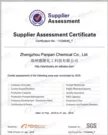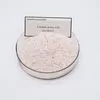Description
Describe
Acetic acid is a common endogenous growth hormone in plants and is a pyridine compound. Also known as long-growth, growth hormone, hetero-growth hormone.
Properties
Acetic acid is an organic substance. Pure products are colorless leafless crystals or crystalline powders. It turns rose when it's in the light. Melting point 165-166 degrees C (168-170 degrees C). It is soluble in aqueous ethanol, ethyl acetate, dichloroethane, and soluble in ether and acetone. Insoluble in benzene, toluene, gasoline and chloroform. Insoluble in water, its water solution can be decomposed by ultraviolet light, but stable to visible light. Its sodium salt, potassium salt than acid itself is stable, easy to dissolve in water. Easy to de-de-de-form 3-methyl -methyl (skunk skunk). It has duality to plant growth, different parts of plant symise with different sensitivity to it, generally larger roots than buds than stems. Different plants are also sensitive to them.
Role
Plant growth hormone. The common natural growth hormone in plants is acetic acid. Acetic acid plays a catalytic role in the formation of the top buds of plant sprigs or shoots, seedlings, etc. Its precursor is tryptophan. Acetic acid is a plant growth hormone growth has a variety of physiological effects, which are related to its concentration. Low concentrations can promote growth, high concentrations inhibit growth, and even cause plant death, this inhibition is related to its ability to induce the formation of ethylene. The physiological effects of growth hormone are manifested in two levels. At the cellular level, growth hormone stimulates the formation of layer cell division, stimulates the cell elongation of branches, inhibits root cell growth, promotes the differentiation of the cells of the wood and ligament sepsis, and promotes the formation of the root of the insert and regulates the morphological formation of the wounded tissue. At the organ and whole plant levels, growth hormone plays a role from seedlings to fruit maturation. Growth hormone controls reversible red light inhibition of embryo shaft elongation in seedlings, the direction of branches is produced when the acetic acid is transferred to the lower side of the branch, the lightness of the branches is produced when the acetic acid is transferred to the backlight side of the branch; the acetic acid causes the top advantage; the growth of the leaf is applied to inhibit the falloff, and the growth of the off-layer end promotes the growth of the growth of the end of the off-layer;
Application
The broad spectrum of acetic acid is multi-purpose, but it is not a commonly used commodity because it is easily degraded outside the plant. Early use was used to induce tomato monosexual strength and sitting fruit, in the bloom ingenuity of 3000 mg / liter of liquid soaked flowers, the formation of seedless tomato fruit, improve the rate of sitting fruit; To 100 to 1000 mg / liter of liquid soaked in the base of the branch, can promote the tea tree, gum tree, eucalyptus tree, water fir, pepper and other crops incurable root formation, speed up the rate of nutritional reproduction. 1 to 10 mg/l acetic acid and 10 mg/l of mold mixed to promote the rooting of rice seedlings. 25 to 400 mg/L of liquid sprayed with a chrysanthemum (in a 9-hour light cycle), which inhibits the appearance of buds and delays flowering. Growing in long sunlight, the sea otter is sprayed once at a concentration of 10 minus 5 square moles/litres, which can increase female flowers. Treatment of beet seeds promotes germination and increases root yield and sugar content.
- Plant growth regulator
- growth hormone
- acetic acid
Production Capacity:
Not informed
Delivery Timeframe:
Depends on Size of Order
Incoterms:
FOB - Free on Board
Packaging Details:
1kg铝箔袋,25kg /桶
More about
PANPAN INDUSTY CO,. LTD
10-50
Employees
Not informed
Not informed
Year
Established
Business type
- Importer / Trading Company
Keywords
- Vegetable growth regulator
Contact and location
-
Hu ********
-
+86 37********
-
Zhengzhou / Henan | China






